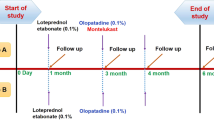Abstract
Purpose
The aim of this study is to evaluate the efficacy of prolonged treatment with preservative-free diclofenac sodium 0.1% eye drops in patients with vernal keratoconjunctivitis (VKC).
Methods
A prospective open study was performed in 22 patients with VKC treated with preservative-free diclofenac sodium 0.1% eye drops. Patients used the eye drops four times daily in both eyes for 120 days. Signs (papillae, hyperaemia and corneal lesions) and symptoms (itching, redness and photophobia) of the ocular surface were graded and statistically evaluated before and after treatment by a non-parametric test (Mann–Whitney U-test).
Results
Forty per cent of the patients showed an improvement in their symptoms at the end of the treatment. Total signs and symptoms scores were significantly decreased at the end of treatment compared with the baseline values (from 6.13±1.45 to 0.81±0.90 and from 5.40±1.18 to 2.63±0.95, respectively; P<0.001). Significant decreases in conjunctival redness (P<0.001), itching (P<0.001) and photophobia (P<0.001 ) were observed at the end of treatment. Conjunctival hyperaemia was significantly reduced (P<0.001) at the end of treatment, while no significant differences were observed for corneal lesions and for papillary size. No patient showed exacerbation of the disease during the treatment.
Conclusion
VKC is a chronic disease that requires prolonged treatment to control the inflammatory process. Our preliminary study demonstrates the efficacy and safety of preservative-free diclofenac sodium 0.1% eye drops in controlling the signs and symptoms of VKC in prolonged treatment.



Similar content being viewed by others
References
Abelson MB, Butrus S, Weston JH (1983) Aspirin therapy in vernal conjunctivitis. Am J Ophthalmol 95(4):502–505
Allansmith MR (1982) The eye and immunology. Mosby, St Louis, pp 118–124
Bhattacherjee P (1989) The role of arachidonate metabolites in ocular inflammation. In: The ocular effects of prostaglandins and other eicosanoids. Liss, New York, pp 211–227
Bielory L, Frohman LP (1992) Allergic and immunologic disorders of the eye. J Allergy Clin Immunol 89:1–15
Bonini S, Bonini S, et al (1992) Conjunctiva hyperresponsiveness to ocular histamine challenge in patients with vernal conjunctivitis. J Allergy Clin Immunol 89(1, Pt 1):103–107
Bonini S, Bonini S, Lambiase A, et al (2000) Vernal keratoconjunctivitis revisited: a case series of 195 patients with long-term follow-up. Ophthalmology 107(6):1157–1163
Buckley RJ (1988) Vernal keratoconjunctivitis. Int Ophthalmol Clin 28:303–308
Burstein NL (1980) Preservative cytotoxic threshold for benzalkonium chloride and chlohexidine digluconate in cat and rabbit corneas. Invest Ophthalmol Vis Sci 19(3):308–313
Burstein NL (1980) Corneal cytotoxicity of topically applied drugs, vehicles and preservatives. Surv Ophthalmol 25(1):15–30 review
Furer P, Berger J, Mayer JM, et al (2001) A comparative study of the ocular tolerance of 3 timolol based preparations: the influence of preservatives on ocular tolerance. J Fr Ophtalmol 24(1):13–19
Gilbard JP, et al (1989) Ophthalmic solutions, the ocular surface, and a unique therapeutic artificial tear formulation. Am J Ophthalmol 15; 107 (4):348–355
Hic J, et al (1984) Comparison of the anti-inflammatory effect of dexamethasone and diclofenac ophthalmic preparations. Klin Monatsbl Augenheilkd 184:494–498
Kana JS, et al (1984) Corticosteroid and the active ion transport of the isolated human lens. Ann Ophthalmol 16:1034–1039
Kaidman GW (1995) Diclofenac and its effect on corneal sensation. Arch Ophhalmol 113:262
Ku EC et al (1986) Effect of diclofenac sodium on the arachidonic acid cascade. Am J Med 80[Suppl 4b]:18–23
Lemp M, Zimmerman L (1988) Toxic endothelial degeneration in ocular surface disease treated with topical medications containing benzalkonium chloride. Am J Ophthalmol 15;105(6): 607–613
Nathan H, Naveh N, Meyer E (1994) Levels of prostaglandin E2 and leukotriene B4 in tears of vernal conjunctivitis patients during a therapeutic trial of indomethacine. Doc Ophthalmol 85:247–257
Palmer RM, Kauffman HE (1995) Tear film pharmacology of eye drops, and toxicity. Curr Opin Ophthalmol 6(4):11–16
Schaefer K (1993) Conjunctivitis of allergic origin:immunologic mechanisms and current approaches to therapy. Surv Ophthalmol 38[Suppl]:115–129
Spada CS, Woodward DF, Hawley SB, et al (1986) Leukotrienes cause eosinophil emigration into conjunctival tissue. Prostaglandins 31:795–809
Szerenyi K, Sorken K, et al (1994) Decrease in normal human corneal sensitivity with topical diclofenac sodium. Am J Ophthalmol 118:312–315
Tauber J, Abelson M, Ostrov C,et al (1994) A multicenter comparison of diclofenac sodium 0.1% to ketorolac tromethamine 0.5% in patients with acute seasonal allergic conjunctivitis. IOVS 35 (suppl):1291
Van Husen H (1986) Topical treatment of anterior ocular disease with diclofenac Na eye drops. Klin Monatsbl Augenheilkd 188:615–619
Author information
Authors and Affiliations
Corresponding author
Rights and permissions
About this article
Cite this article
D'Angelo, G., Lambiase, A., Cortes, M. et al. Preservative-free diclofenac sodium 0.1% for vernal keratoconjunctivitis. Graefe's Arch Clin Exp Ophthalmol 241, 192–195 (2003). https://doi.org/10.1007/s00417-002-0612-6
Received:
Revised:
Accepted:
Published:
Issue Date:
DOI: https://doi.org/10.1007/s00417-002-0612-6




